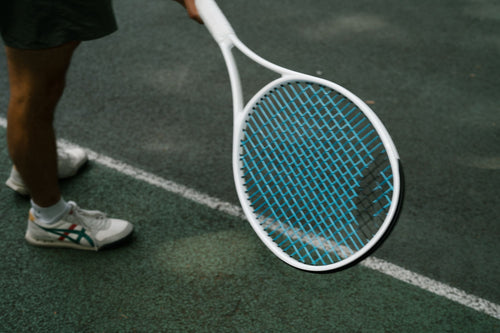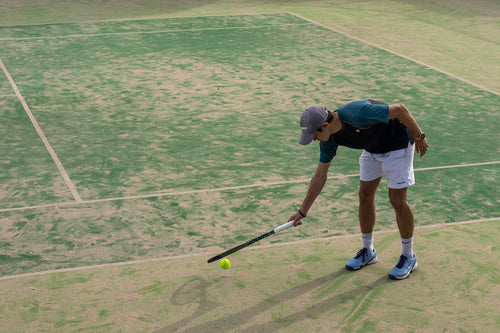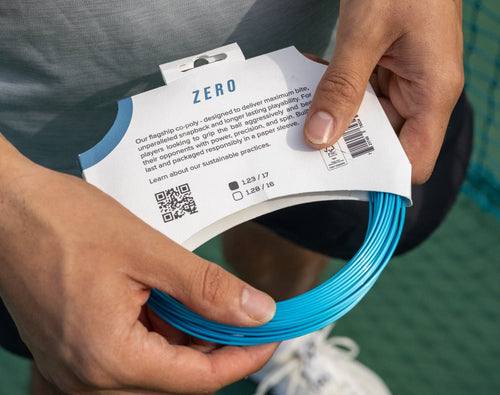ReString Mailbag October 2025
Juan
We're back for another mailbag, where we answer real questions from customers.
This month, we will cover Zero string fraying, hybrid tension differentials, setup recommendations for the Wilson Blade 98 and Clash 100 V3, polyester and synthetic gut hybrid, and finding the right string for the Yonex EZONE 98.
Question 1 - Zero String Fraying
Hi, I recently restrung my racket with the Zero and really like the string. However, after about 8-10 hours of play I noticed that the strings are shredding quite a bit on the crosses.
This has not happened to me when I use Hyper G or Head Lynx tour, so I'm wondering if this is normal for the Zero, or if it might be a production defect. I'd be happy to share photos. Thanks!
ReString Response
Thanks for reaching out and for sharing your experience with Zero.
Regarding the fraying you're noticing on the crosses, a bit of this can indeed happen with our Zero string, although it's not something we see in all cases. This is due to the unique design of the string's ultra-slippery coating, where the snapback-aiding solution is integrated throughout the product, rather than solely on the outside "coating" as is common with most typical polys.
As the strings decay with use, they can begin to fray, but will remarkably remain very slick. With most conventional polys where the coating is only applied on the exterior, you won't experience fraying but you will likely experience a stringbed that dies quickly as the coating erodes after a few hours (leading to poorer playability over time).
To combat this, our strings have been designed to keep snapping back long into the string's lifespan and as a byproduct, fraying can occur as the string naturally starts to thin (especially if you are a spin oriented player / use string bed that has a fairly open string pattern).
That being said, this fraying should not impact the playability but rather indicates that the end of the string's lifespan is approaching.
We're happy to assist you any further and ensure you're having the best possible experience with our strings. Appreciate you reaching out once again.
Question 2 - Hybrid Tension Differential Advice
I have a tech question. In your blog post on hybrid string tensions, you promote the idea of stringing your main strings 2-3 pounds HIGHER than the crosses.
My question is:
Does that differential increase, decrease, or stay the same when you are playing with a denser string pattern (Head Gravity MP 16x20)?
Does that differential increase, decrease, or stay the same if you are playing with 18-gauge Sync in the crosses rather than the 17-gauge?
I would be very grateful for your feedback and advice.
ReString Response
Thanks so much for reaching out with such great questions!
It's always awesome to hear from players who are thinking deeply about their string setups (and also thank you for reading our blogs!)
You've hit on some really insightful points regarding hybrid string tensions. The idea behind stringing mains 2-3 pounds higher than the crosses is indeed a fantastic way to boost the forgiveness of your racket and add a little more pop without having to drastically change your setup. It's particularly effective for increasing spin potential, as the looser crosses reduce friction, allowing the main strings to slide across them more freely.
Regarding your first question about denser string patterns: you're absolutely right in thinking that a denser cross pattern (like a 16x20 Head Gravity MP) means less string spacing. This, in turn, gives your main strings less wiggle room to move freely.
In this scenario, increasing your tension differential to the 3lb mark, rather than 1 or 2 lbs, would be beneficial. This increased differential helps compensate for the denser pattern, allowing your mains to maintain more freedom of movement.
Your second question about using 18-gauge Sync in the crosses instead of 17-gauge is also excellent! Generally speaking, thicker strings do provide slightly less string spacing because, well, they're thicker. However, the difference is quite marginal.
Thicker strings also tend to lose tension a bit slower than thinner strings. With thinner strings, you're already getting a little more string movement, and they'll loosen up a bit faster anyway. So, if you're using thinner crosses, you won't need to increase the differential too much.
I'd suggest keeping it on the lower end, around 1-2 pounds, if you choose to implement a differential. With thicker strings, you'll likely notice the benefits of the differential more, so sticking to the 2-3lbs mark would be a good strategy there.
To sum things up, the string pattern definitely affects the differential you might want to apply. The denser your crosses are, the more differential you'll likely want to observe. As for the cross string thickness, while not as crucial a factor as the string pattern, as a general rule of thumb, a thicker string could benefit from a slightly higher differential.
However, this string gauge factor won't be as influential as your first question about string pattern density. Hope this feedback helps you fine-tune your setup!
Let me know if you have any more questions.
Question 3 - Wilson Blade 98 Setup Recommendation
Hi, so I was thinking of restringing my Wilson Blade 98.
I currently use ALU Power for mains and crosses. I am thinking of restringing it different where I have ALU Power rough in the mains at tension around 56/57lbs and thinking if I should have my crosses as Sync, Zero, or ALU Power rough at tension 54.5/55lbs.
The issue I have been encountering when stringing both at the same tension is that if I hit flat shots too hard, it'll go long, so what set up should I get to ensure that even if I hit a hard flat that it drops into the court?
ReString Response
Thanks for reaching out with your question and for the excellent racket choice! I'm a big fan of the Blade 98 myself and have used it for a long time.
Looking at your current setup, I would definitely recommend trying Sync in the crosses at a tension of around 2 lbs lower than your mains. There are a few reasons for this. While ALU Power Rough is an excellent string known for its control and feel, it doesn't offer great snapback.
The string isn't as slippery, which limits string movement. With less snapback and string movement, you essentially get less rotation on the ball, which likely contributes to your harder flat shots going long.
Sync is a fantastic alternative in this regard. We've engineered it to also provide excellent feel and control, but with the added benefit of our signature snapback. Since Sync strings are super slippery, they allow the mains to slide freely against the crosses, facilitating more string movement and spin.
The result is that with your strokes, especially those harder hits where the ball moves faster, you'll be able to generate more string movement and therefore more dipping spin, helping your balls land in the court.
The 2 lbs tension offset further enhances this effect; with a slightly lower tension on the crosses, you get a bit more string movement to help those balls dip.
So, if you want to stick with your ALU Power in the mains as a more familiar set up, I would definitely consider Sync in the crosses. Another alternative we often recommend is a hybrid setup with our Zero in the mains and Sync in the crosses.
Zero is a shaped string that provides excellent bite on the ball and great pop. Sync, as mentioned, is a control and feel-oriented string with fantastic snapback, making it pair really well with our Zero. As far as hybrid setups go, this one is definitely one of our top sellers!
I hope this helps, and I'm happy to assist further if you have any more questions.
Question 4 - Clash 100 V3 String Recommendation
Hi - probably not the type of racquet you guys are usually asked about, but I have a Clash 100 v3 and I'm looking for a string for more control and spin while still comfortable. Is there a setup from ReString you'd recommend (string and tension)? Thanks!
ReString Response
Thanks so much for reaching out and for your question!
I actually used to play with a Clash 98 myself, so I'm very familiar with those soft, buttery frames. I totally get that you might be looking for something a tad more controlled, as the Clash line does offer quite a bit of power.
I would definitely say that Sync is your best bet here in terms of our offerings. It's our most controlled string that also provides excellent feel. Despite being rounded in shape, it features our signature snapback coating, which allows for really good string movement.
This, of course, then gives you more spin when you hit the ball. In terms of softness, it's pretty comfortable for a co-poly string. Of course, if you're used to playing with a hybrid or a multi, any poly will feel a touch stiffer, but as far as polys go, Sync offers a really nice, comfortable ride.
Tension-wise, I would suggest going 2 lbs lower than your usual tension for a poly string. For example, if you typically string around 50 lbs with your usual poly, I would recommend going with 48 lbs for Sync. 2lbs lower gives you a bit more comfort and also enhances spin. If you don't quite know where to start, I would say 50-52 lbs is a very sensible range.
Why don't you start with that? If you find that you want an even more controlled response with even better spin, another popular setup is to put our Vivo strings in the mains with the Sync strings in the crosses. That being said, this would stiffen up the stringbed slightly more.
Happy to advise on that at a later time so feel free to send us any more questions!
Question 5 - Polyester and Synthetic Gut Hybrid
I like to play with poly/synthetic gut hybrid in 20/22 kg range as I'm looking for poly control/spin with added touch, feel and most important comfort.
As synthetic gut I'm using TNT2 React Pro in 1.27 usually with round poly.
May I have some advise on a string that will work fine as main with the above synthetic gut in cross? Thanks for feedback.
ReString Response
Thanks so much for reaching out with your question!
It sounds like you have a great setup with your preferred poly/synthetic gut hybrid, aiming for that balance of control, spin, touch, feel, and comfort.
Given your use of TNT2 React Pro 1.27 as a soft synthetic gut in the crosses, I would definitely suggest a poly with a round profile, such as our Sync.
The round shape of the string will ensure it slides very smoothly against your softer cross string, which is key for both playability and durability. In contrast, a shaped poly can tend to "bite" into the cross string, potentially causing premature wear and reduced longevity.
Sync would be an excellent choice for you in this scenario. We frequently see it used as a popular hybrid option, especially when paired with softer strings, due to its ability to complement them so well.
Hope this helps!
Question 6 - Yonex EZONE 98 String Recommendation
My current string set up is back and forth between Yonex PolyTour Rev 1.25 in the mains with PolyTour Pro 1.25 in the crosses at 52 pounds all around, or PolyTour Pro 1.25 in a full bed, also strung at 52 pounds. I'm using a newer Yonex EZONE 98.
I like the extra bit of power and spin the Rev provides over the Pro, but the Pro is more predictable and controlled while feeling more lively compared to the Rev's more muted feel. The Pro also feels like it plays more consistent.
I'm looking for new mains (possibly full bed) that work well in my EZONE, a string that does everything well and has better tension maintenance and can keep its performance longer. I'm looking for something similar to PolyTour Pro, but with better power and spin qualities like the PolyTour Rev.
Let me know if any of your strings sound like that. Thank You
ReString Response
Thanks for reaching out to us!
It sounds like you're looking for a string that balances the spin and power of PolyTour Rev with the control and consistency of PolyTour Pro, all while offering better tension maintenance.
We definitely have a couple of options that I think you'll find interesting: Sync and Zero. Both of these strings are excellent performers and we've actually heard from quite a few players who have switched over from PolyTour Pro with great results.
Both Sync and Zero will offer excellent snapback and spin. Zero takes the spin to an extreme, thanks to its hexagonal shape, and will also give you more power.
However, given that you seem to really like the round profile of PolyTour Pro, Sync might be a particularly great alternative for you. Sync will provide better spin and longevity, largely due to our signature long-lasting snapback coating. It's definitely worth a try!
I'd suggest trying either of them at the same tension you're currently using.
Let us know if you have any other questions!
Got Your Own Question?
We'd love to hear from you and share the best response we can to help your game.
If you have your own question, you can submit that via our contact page.
Until next month, enjoy your tennis!
Questions and responses may be lightly edited for easier reading.
About the Author: Juan is the co-founder of ReString. He was born in Argentina, raised in Japan, and moved to the US to pursue college tennis. He now plays as an ATP & WTA hitting partner.













